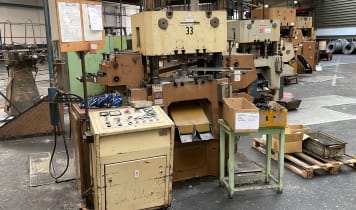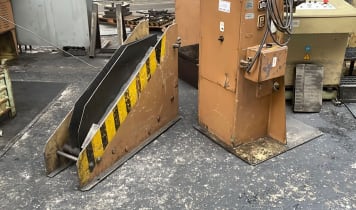Tool machines manufactured by WMW (also referred to as VVB to denote its membership of a state-wide manufacturing association) were divided into four divisions. Each division, or combine, was located in a different city and was responsible for producing their particular product group. The collaboration worked amazingly well, and WMW was able to continue building on its excellent international reputation. By the end, 70% of all WMW machines were exported and not simply to other bloc countries; Western companies also highly valued the quality of machines bearing the ‘Made in GDR’ seal.
The following overview shows the distribution of the individual production areas within the association:
Combine HECKERT NILES Erfurt Smalcalda
Products - Plastic processing machines
- Tools
The Heckert combine based in Chemnitz (then: Karl-Marx-Stadt) was responsible for the following product areas:
- WMW Heckert milling machines
- WMW Heckert boring machines
- WMW Heckert slotting machines
- WMW Heckert planning machines
- WMW Heckert broaching machines
This combine, or state-held company, thus covered every form of non-radial cutting machine in a variety of sizes and designs. Despite only 30% of production remaining within the country, there is a wide selection of WMW milling machines on the market of used machinery to this day. They are often in a very used condition, but can generally be brought back into shape with ease thanks to their robust design. Used WMW boring machines and milling machines are a big hit thanks to amazingly low prices. Entirely functional machines can be acquired for as little as 1000 Euros.
WMW’s boring machines fell into three categories: column and pillar drills, radial drilling machines and hand-held drills. Socialist philosophy demanded that all industrial goods should be easy to repair and this was taken very seriously when designing machines. This approach has made WMW drilling machines highly popular in developing countries and emerging markets since they can always be easily maintained using the materials on hand. WMW machines, and drills in particularly, can thus be seen as having played a large part in the development of these countries. In India, for example, WMW is a mainstay in every metalworking operation.
The Niles combine in Berlin was primarily responsible for lathes and grinding machines. In addition to a large number of small- and mid-sized model, this combine’s primary claim to fame was the manufacture of large lathes and turning machines. It is where GDR engineers and workmen presented the products that enabled them to keep up with the West for as long as they did. WMW carousel lathes with diameters of ten metres and up were the main specialities of this state-held combine, but they also continually set new standards in machinery designed for the horizontally processing of turned parts.
Production of numerically-controlled tool machines started very early at WMW, however the majority of WMW lathes were intended solely for manual operation. WMW turning machines were available in all prevalent sizes and their quality is still so high today that even second-hand, conventional, mid-sized lathes continue to command a substantial price. Acquiring a used centre lathes made by WMW, for instance, can cost upwards of 5,000 Euros. A mid-sized, vertical turret lathe for workpiece diameters of only 2000 millimetres can cost more than 20,000 Euros – even for machines dating back more than 40 years. It is the reliability, stability and precision of their machines that justify such seemingly high price tags.
This state-held forming technology firm, or HERBERT WAHNKE based in Erfurt, was primarily tasked with manufacturing machines for forming and shaping materials. Presses, bending presses, deep-drawing presses, as well as guillotine shears , and later even plastic-processing equipment, were produced at this firm.
As with other WMW companies, their presses, punching machines soon built a reputation for quality around the world. The Erfurt combine strove to supply the entire international market with presses and other machinery: very powerful hydraulic presses to apply large deformation forces took up a large part of production and development in Erfurt. Rapid eccentric presses for efficient mass production were also on offer and WMW was able to contribute to the industrialisation of the socialist brotherhood around the globe. It is primarily their powerful hydraulic presses that can still be found in large numbers in the second-hand marketplace. The most frequently encountered used WMW presses are c-presses and double-column presses and are available across a broad price range. These machines, too, are serviced by modern-day companies who can provide replacement parts, operating manuals, repair guides and perform upgrades.
WMW strove not only to produce the world’s best tool machines; the purpose of this combine was to manufacture production tools. The Smalcalda combine manufactured tools for punching machines, presses, metal-cutting machines, and injection moulding machines. Their international clientèle thus had a one-stop destination for all their tool and production line needs. The Smalcalda combine even produced electrical tools for domestic users, such as drills and other hand-held devices. As might be expected, the market for used tools is significantly smaller than for the corresponding machines – tools for presses, punching and injection moulding machines are very hard to come by. These components are naturally exposed to a great deal of wear and tear and are generally manufactured for very specific applications. Nevertheless, the tools manufactured at the Smalcalda combine show just how capable the GDR was when it came to machinery and production.


















